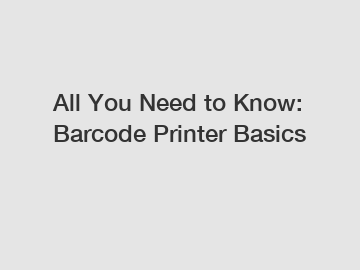All You Need to Know: Barcode Printer Basics
Barcode printers are essential tools for businesses looking to improve efficiency, accuracy, and productivity in their operations. Whether you are new to using barcode printers or looking to upgrade your current system, it is important to understand the basics of how barcode printers work and which features to consider when selecting a device for your business needs.
Types of Barcode Printers.
There are several types of barcode printers available on the market, each with its own unique features and capabilities. The most common types of barcode printers include:

1. Direct Thermal Printers: These printers use heat-sensitive paper to print barcodes. They are ideal for applications where the printed labels will not be exposed to extreme heat, light, or chemicals.
2. Thermal Transfer Printers: These printers use a thermal print head to transfer ink from a ribbon onto the label. They are ideal for applications where the printed labels need to be more durable and resistant to fading and smudging.
3. Inkjet Printers: These printers use liquid ink to print barcodes on labels. They are versatile and can print high-quality images and text in color, making them suitable for retail and product labeling applications.
4. Laser Printers: These printers use toner to print barcodes on labels. They are fast and can produce high-quality prints, but they are typically more expensive than other types of barcode printers.
Key Features to Consider.
When selecting a barcode printer for your business, there are several key features to consider:
1. Print Resolution: The print resolution of a barcode printer determines the clarity and sharpness of the printed barcode. Higher resolution printers are capable of printing smaller barcodes with greater detail.
2. Print Speed: The print speed of a barcode printer refers to how quickly it can print labels. Faster print speeds are ideal for high-volume applications where efficiency is critical.
3. Connectivity Options: Barcode printers can connect to a computer or network using various connectivity options, such as USB, Ethernet, Wi-Fi, or Bluetooth. Choose a printer with connectivity options that are compatible with your existing systems.
4. Label Width and Length: Consider the size of labels you will be printing and select a barcode printer that can accommodate the width and length of labels required for your applications.
5. Durability: Depending on your application, you may need a barcode printer that is rugged and durable enough to withstand harsh environments or conditions.
Maintenance and Support.
To ensure optimal performance and longevity of your barcode printer, it is important to perform regular maintenance tasks, such as cleaning the print head and replacing consumables like labels and ribbons. Additionally, consider purchasing a maintenance plan or service agreement to receive technical support and repairs if needed.
In conclusion, understanding the basics of barcode printers and selecting the right device for your business needs can help improve efficiency and accuracy in your operations. By carefully evaluating the types of barcode printers available, key features to consider, and maintenance requirements, you can make an informed decision when choosing a barcode printer for your business.
Contact us today to learn more about barcode printers and how they can benefit your business operations.
Want more information on which is the best barcode printer, durable barcode printer, healthcare label printing software? Feel free to contact us.

Comments